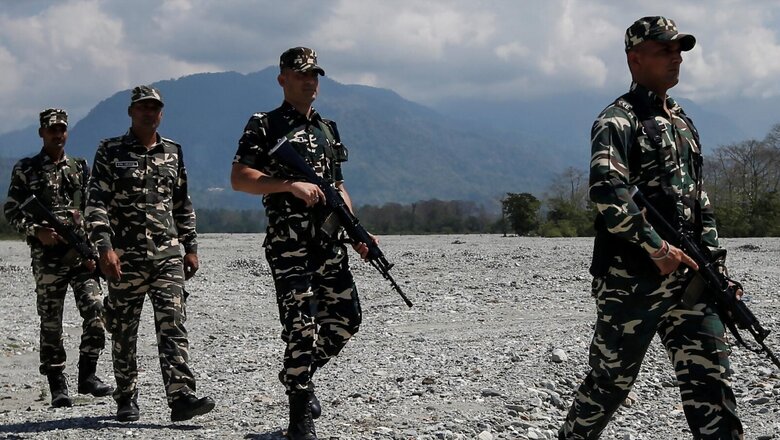
views
After the Chinese aggression in 1962, the government of India felt the need for a force that could mingle with civilians but work as an intelligence-gathering machine. The Special Service Bureau, now Sashastra Seema Bal, was born to lend a hand to India’s national intelligence agency. But now the force, which has close to 1 lakh jawans, is primarily responsible for guarding two borders: Nepal and Bhutan. The change in role took place after the Kargil war when the government decided to have a ‘one border, one force’ concept.
After the Kargil war, the SSB was declared a border guarding force under the ministry of home affairs and renamed Sashastra Seema Bal on December 15, 2003. It was tasked to guard the Indo-Nepal border and after one year got additional responsibility of securing the Indo-Bhutan frontier as well as became the lead intelligence agency for that border. The SSB is now spread along the international border across Uttarakhand, Uttar Pradesh, Bihar, West Bengal, Sikkim, Assam, and Arunachal Pradesh.
History
After the conflict with China in 1962, the government of India felt that borders need unarmed soldiers also who would assist the armed forces in case of any movement from the enemy side. The Special Service Bureau (now Sashastra Seema Bal) was planned in November 1962 and formally created after four months with the primary objective to have ‘total security preparedness’ in the border areas.
The Special Service Bureau was initially started in a few states, which included Assam, North Bengal, the hill districts of Uttar Pradesh (that later became Uttarakhand), Himachal Pradesh, parts of Punjab and the Ladakh area of the then Jammu and Kashmir state. Due to its success in border areas, the jurisdiction of the SSB was extended to Manipur, Tripura, Jammu, Meghalaya, Sikkim, Rajasthan, South Bengal, Nagaland, and Mizoram.
The SSB was tasked to cover a population of close to 6 crore people living in 80,000 villages spread over 9,917 kilometres. These areas were carved up into divisions that were further segregated into areas and subareas, followed by circles. The SSB during its early days used to have 10 divisions each headed by a divisional commissioner, 49 areas managed by area organisers, 117 subareas headed by subarea organisers, and 287 circles supervised by circle organisers. For combat, it also had two dozen battalions that used to provide arms training to volunteers. The SSB also opened various training centres to train these volunteers.
By 1990, the force had seven major training centres and seven women’s advanced training schools. Training was given to the border population situated in Himachal Pradesh, Punjab, parts of J&K, UP, North Assam, North Bengal and South Bengal. Locals were trained to use small arms as a process of self-defence during war-like situations or any attack. These volunteers also worked as eyes and ears of the SSB.
But, after the Kargil war, the government of India decided to have a change in policy related to borders and finalised a plan based on ‘one force, one border’.
In 2001, the SSB was transferred from the Research and Analysis Wing (R&AW) to the direct control of the ministry of home affairs. The force changed its primary task and was deployed to guard the Nepal and Bhutan borders. It was renamed Sashastra Seema Bal and became the newest paramilitary outfit.
With the change in role, the SSB was also declared a central armed police force (CAPF) and became the lead intelligence agency for the Indo-Nepal border in June 2001. The force was also tasked to guard the Indo-Bhutan border stretched over 699 km in states like Sikkim, West Bengal, Assam and Arunachal Pradesh. It also decided to recruit women for its battalion for the first time in any central armed police force.
Stories of valour
Due to the force’s deployment in various sensitive areas, SSB jawans have been awarded many medals including Kirti Chakra, Shaurya Chakra, etc.
In 2009, when Assam was facing tensions due to insurgency, the SSB played an important role. On April 9 that year, an SSB team was moving towards Kalachand where troops of another battalion were stationed. Their vehicle was ambushed and fired at from either side of the road. Sub-inspector (general duty) or SI (GD) Bhupal Singh along with his teammates fought the insurgents and repulsed the attack.
During the early days, the SSB used to develop volunteers in various border areas to gather intelligence. This strategy helped the force in a big way. The SSB played an important role in getting insurgents to surrender. A Mizo gang during the late 1970s surrendered after the force intervened. This was the biggest such Mizo gang at the time, headed by Demkhosei Gangte, a self-styled political adviser to the Mizo National Front. The gang had 53 other hardened Mizo rebels who used to carry sophisticated weapons.
The SSB also played an important role during the Kargil war. Its field officers were tasked to provide information about the enemies who were in touch with locals.
The force also eliminated Naxal commanders and various insurgents. In 2016, the SSB rescued 59 children who were trafficked from Bihar and were being taken to Mumbai.
Budget
The SSB has been allocated Rs 7653.73 crore for the year 2022-23. In recent years, the government has increased the budget of the force since it is deployed in some strategic locations in Arunachal Pradesh.
Strength and structure
A senior Indian Police Service (IPS) officer at the level of director general heads the force, which has close to one lakh personnel. The DG supervises all inspectors general (IGs) and an additional director general-rank officer. The force has various departments, including operations and intelligence, personnel and training, administration, etc, which work under IG-level officers. The force is also divided into frontiers, which are Ranikhet, Lucknow, Patna, Siliguri, Guwahati, and Tezpur, which also work under IG-level officers. The SSB has 16 IGs and one ADG who work under the DG. The force from 1968 to 1972 had also worked under an IAS officer. In 2016, the SSB saw a historic moment as for the first time a senior woman IPS officer took charge of any central armed police force. Archana Ramasundram was DG SSB for close to a year.
Training
SSB jawans get training in various fields, including guerrilla warfare, counterinsurgency, intelligence, jungle and snow survival, etc. The force has one of the oldest training centres for jawans as well as civil cadres. The SSB has an intelligence learning centre in Delhi as well for jawans and officers.
Read all the Latest News India and Breaking News here


















Comments
0 comment